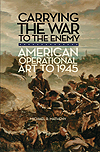 Carrying the War to the Enemy: American Operational Art to 1945, by Michael R. Matheny, University of Oklahoma Press, Norman, 2011, $45
Carrying the War to the Enemy: American Operational Art to 1945, by Michael R. Matheny, University of Oklahoma Press, Norman, 2011, $45
In Carrying the War to the Enemy, Michael R. Matheny describes the evolution of schools responsible for the study of operations in the U.S. military. In 1881 General William T. Sherman ordered the establishment at Fort Leavenworth, Kan., of the School of Application for Cavalry and Infantry, which in 1907 expanded into the School of the Line and the Army Staff College (today’s Command and General Staff College). Atop the postgraduate system was the Army War College, opened in 1904. The Navy opened the Naval War College in Newport, R.I., in 1884, and in 1920 the Army established the Air Corps Tactical School at Langley Field, Va.
The author notes that a dearth of great American military thinkers in their curricula has led historians to overlook the work those schools did to prepare the officers who played such vital roles in World War II. Matheny cites four major examples of successful combined operations: Torch, the invasion of North Africa in 1942; Overlord, the invasion of Normandy in 1944; General Douglas MacArthur’s return to the Philippines in 1944; and Iceberg, the 1945 invasion of Okinawa. Those operations, the author contends, raised U.S. armed forces to the level of the Germans in terms of operational efficiency.
All that experience was lost with the advent of nuclear warfare and the belief that mutual destruction precluded the need for operational studies—a viewpoint that cost the United States dearly in Vietnam. The U.S. military learned from its mistakes, however, and the study of the operational art again gained high priority. Matheny fills a vacuum in military historiography with this book, while reminding us that great victories are not won by accident.
—Thomas Zacharis




